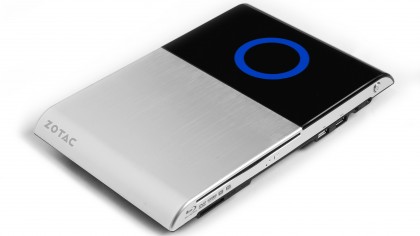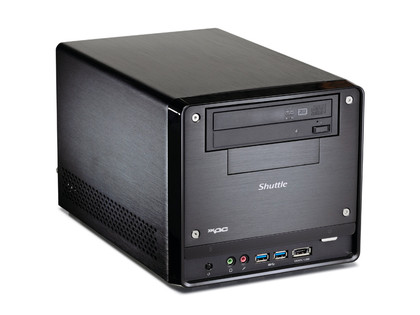Best mini barebones PCs: 5 top options to build your own media PC
A media streaming box can do a lot, but a barebones PC can do more
For Connectivity it offers a combination of HDMI, mini DisplayPort for secondary screens, two USB 3.0 ports and an inbuilt Wi-Fi card. If you need a VGA output then you can get a mini DisplayPort adaptor, but you'll be left without sound as there's no analogue audio output - sound can only be outputted via HDMI.
The base model Brix doesn't set the world on fire with its performance, but will still happily cope with office productivity and any kind of media playback, including on-demand TV.
What to add on
The Brix comes with an embedded processor, but you still need to add on some laptop-type SODIMM memory and an mSATA hard-drive to get things going. As with the rest of the PCs here, your choice of OS comes down to Windows (7 or 8) or a variety of Linux distributions depending on what you're doing.
- A minimum of 2GB of 204-pin SODIMM memory.
- We recommend a 60GB or higher mSATA SSD.
- Wired or wireless keyboard.
- Network cable or HDMI cable.
3. The full HD media player
Why you can trust TechRadar
Zotac ZBox Blu-Ray - from £210 (around USD $343, AUD $379) - Ebuyer

The Blu-Ray AD03 from Zotac is one of the few barebones PCs out there with an optical drive, but Zotac clearly know their market for this kind of form-factor and have included a Blu-ray drive, making this little PC the perfect HD Media centre.
To ensure smooth 1080p playback, the 1.8GHz AME E-350 APU includes AMD6310 graphics, giving about as much graphic grunt as you'll get without a separate graphics card in a PC of this size. There are also more ports to go around, including DVI as well as HDMI, analogue audio output, full-sized SATA for 2.5" HDD or SSDs, an E-SATA for fast external storage, a 6-in-1 card reader, wired and wireless connections (up to 300Mbps) and 4 USB ports - two of which are USB 3.0.
At lower resolutions the AD03 will even double as a casual gaming PC. There are plenty of Indie games on Steam, browser-based games on the Chrome Store and of course, there's nothing wrong with retro!
What to add on
With a processor already onboard, you'll just need some SODIMM memory and a 2.5" SATA hard-drive or SSD to finish it off.
- A minimum of 4GB of 204-pin SODIMM memory.
- We recommend a 500GB HDD or an SSD.
- Wired or wireless keyboard.
- Network cable or HDMI cable.
4. The pint-sized server
Shuttle SH67H3 - from £219 (around USD $358, AUD $393) - Ebuyer
Read TechRadar's full review of the Shuttle SH67H3

Shuttle have been in the barebones business since the start, being a pioneering driving force behind the mini-ITX form factor since the days of socket-A. These days they're very much viewed as the standard in building a small (but powerful) desktop or media PC. Thanks to the extra space afforded from a full ITX chassis, you can fit in any 5.25" optical drive and two 3.5" drives for plenty of storage, plus there's space for dual-height graphics cards.
Despite the small form factor, you're not hugely limited as to your choice of components. The Shuttle supports an Intel Core i3, Core i5, Core i7 Sandy Bridge CPU, up to 32GB of RAM, and has all the connectivity you'd expect to find in a full tower PC including four SATA interfaces, S/PDIF optical out, eight USB ports including four USB 3.0 and a whole lot more.
Shuttles are really nicely made and look the part thanks to a sleek brushed aluminium exterior. They offer all the flexibility you could want for a home media server, gaming machine or anything else you'd expect a full-sized PC to do.
What to add on
This barebones comes with a motherboard, heat-pipe CPU fan and PSU, but you'll need to add a socket 1155 processor, DDR3 memory and at least one 3.5" SATA hard-drive or SSD to boot.
- A Socket 1155 Core i3, i5 or i7 processor
- A minimum of 4GB of 204-pin SODIMM memory.
- We recommend a 2TB HDD and / or an SSD.
- Wired or wireless keyboard and other peripherals.
- A network or HDMI cable.
5. The console beater
ASRock M8 - Dabs
The new-generation consoles are thoroughly at war, but there's a third option that, despite being a little more pricey, can afford you with graphical quality that's even higher than either Sony or Microsoft's offerings. The offspring of a design co-operative between ASRock and BMW, The M8 verges on mini-pc erotica.
Not only can it compete amongst the best in CPUs and GPUs thanks to a Haswell-compatible Z87-M8 motherboard, but the M8 has some interesting design features outside as well as in. Firstly, there's the 'A-Command' OLED display on the front of the case. This display can adjust its orientation depending on whether you have the M8 horizontal or vertical, and displays a whole host of information including CPU speed, time and date, volume and also lighting controls for the inside of the case.
Other highlights of this little beast include space for up to five 2.5" drives, or else one 3.5" and one 2.5" drive, excellent onboard sound from Creative, space for two SODIMM memory modules, and just about enough space to cram in a double-height graphics card such as a NVIDIA 760. Though the M8 doesn't come with an included CPU cooler, it can take most heatsinks up to about 90mm tall, which is pretty good for a Mini-ITX case.
What to add on
This barebones PC comes with a motherboard, heat-pipe CPU fan and PSU, but you'll need to add on a socket 1155 processor, DDR3 memory and at least one 3.5" SATA hard-drive or SSD to boot.
- An LGA1155 Core i3, i5 or i7 processor.
- An appropriate Cooler (such as the ThermalRight AXP100)
- A minimum of 8GB of 204-pin SODIMM memory.
- A beefy graphics card such as the Asus GTX 760 DCU II.
- We recommend a 1TB HDD and / or 2.5" SSD (or 5!).
- Wired or wireless keyboard and a gamepad.
- Additional cabling such as network or HDMI.
- Now why not read TechRadar's guide to the best free video editing software?
Sign up for breaking news, reviews, opinion, top tech deals, and more.